Founders
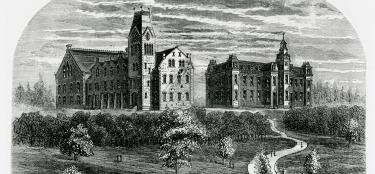
John Boynton
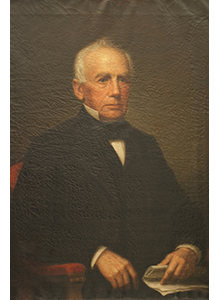
As Stephen Salisbury observed in a memorial notice read into the minutes of a meeting of the trustees in the spring of 1867, John Boynton had been "modest and reserved in his disposition." By his request the architects of the college he founded kept his name a secret until his death. Naming the college's first building for him was not just a way of honoring his memory, but of revealing, at last, the identity of the mysterious benefactor who had given the Worcester community such a wonderful gift. Boynton was born to modest means and lived his life in the careful, thrifty manner of the many who as children had known poverty. Born in 1791, he worked his father's farm in Mason, NH, until he was 30, then set up a small business in a nearby town to make and sell tinware. He soon moved the business to Templeton, MA, where he operated it until his retirement in 1846. He left the operation in the hands of his cousin, David Whitcomb, in whom he would later entrust his dream of establishing a college. At retirement, he served for a short time in the Massachusetts legislature, then moved to Athol, MA, to become the first president of the Millers River Bank. After retiring from that post he returned to Templeton, where he lived until his death on March 25, 1867. He outlived two wives and had no children, so as he approached the end of his life he pondered how to dispose of the bulk of his estate. He gave some to family members. "In his peculiar, quiet manner," Salisbury said, he gave $10,000 to the public schools in Mason, NH (In 1989 the nearby town of New Salem, NH, which receives support from the Boynton Fund, named a new middle school for him.). The rest he gave to his new college.
WPI Journal, Spring 1990 p. 6
Ichabod Washburn
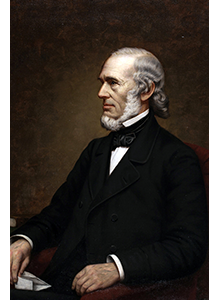
Ichabod Washburn and his twin brother Charles were born in 1798 in Kingston, MA, children of a mariner who died at sea while they were still quite young. Ichabod left home when he was nine and at the age of 16 became an apprentice blacksmith in Leicester, MA. By the time he was 20, he was a journeyman blacksmith. After a brief detour in his brother-in-law's mercantile business, he set up his own forge in Millbury, MA. With a small investment from a Worcester businessman, Washburn moved his business to that city, where he made ramrods, machinery and lead pipe. In 1835 he set up a company with his brother to make wire and wood screws in a building constructed by Stephen Salisbury II. Washburn invented a new process for drawing iron wire that revolutionized the industry, and his business grew rapidly. In the next few years the brothers created and dissolved several firms, but ultimately went their separate ways. Ichabod set up a new wire-making company with his son-in-law, Phillip Moen. The new enterprise realized great success with its piano wire. Its work force grew from 120 in 1859 to 3,000 in 1889, and its product line expanded to include tele- graph wire, hoop-skirt wire and insulated wire. By century's end, it was the largest company of its type in the world. Deacon Washburn, as he was known through much of his life, began early in his career to share his wealth with others. In addition to his contributions to WPI, he made possible the construction of Mechanics Hall; founded Memorial Hospital and the Home for Aged Women in Worcester; and contributed liberally to a wide range of educational, religious and charitable institutions in the city and around the region.
WPI Journal, Spring 1990 p. 11
Stephen Salisbury II
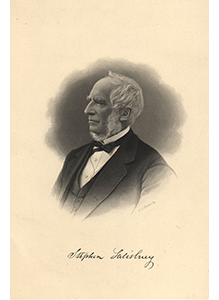
Through enlightened philanthropy, three generations of men with the name Stephen Salisbury shaped Worcester's most important institutions and, in many ways, made the city what it is today. Stephen Salisbury I came to Worcester from Boston in 1767 to open a branch of the family mercantile business. His only surviving child, Stephen Salisbury II, was born in 1798. He graduated from Harvard University and remained a scholar of the classics throughout his life. In 1829, he inherited his father's sizeable estate. While he remained a gentleman farmer, he became deeply involved in the life of an increasingly industrial city. He served in city government and spent four years in the Massachusetts legislature. He extended his generosity to such institutions as the American Antiquarian Society, the Worcester Free Public Library, the Massachusetts Historical Society, Harvard University and the Worcester Mechanics Association. He was the first president of the Board of Trustees for the Worcester County Free Institute of Industrial Science, a position he held until his death in 1884. His interest in classical education led him to bequeath to the Institute $10,000 as a fund for instruction in languages. Overall he gave far more than the $236,800 in gifts that appear on the college's books. He survived three wives and had one child, Stephen Salisbury III, who took his father's place on the Institute's board. Stephen III also continued his father's legacy of philanthropy and is best remembered as the founder of the Worcester Art Museum. He donated $100,000 to WPI in his father's memory to build Salisbury Laboratories, and gave the city 18 acres of land to create Institute Park across from campus.
WPI Journal, Spring 1990 p. 12
Seth Sweetser
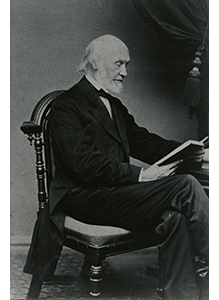
While others may have earned the title of formal founders of WPI, Seth Sweetser, perhaps more than any of those present at the birth of the college, helped shape its mission and profoundly influenced its future. Sweetser was born in Newburyport, MA, in 1807. After graduating from Harvard, he spent a few years as an instructor and tutor before enrolling at the Andover Theological Seminary, from which he graduated in 1834. He later received a doctor of divinity degree from Amherst College. He served briefly in a parish in Gardiner, ME, before being called to Worcester to become the pastor of the Central Congregational Church (now the United Congregational Church). He remained in this post until his death, becoming one of the city's most beloved clergymen. Deeply interested in education (he was once president of the American Education Society), he served on the boards of trustees of several New England schools and colleges and was associated with Harvard, as an examiner and overseer, for several decades. He was well-versed in mathematics and science, and was, therefore, well-prepared to help when David Whitcomb brought John Boynton's plan to his attention eight years later. It was largely Sweetser's counsel that led Ichabod Washburn to join in the founding of the new Institute. Sweetser's contributions to the birth of WPI were acknowledged by Stephen Salisbury II upon Sweetser's death in 1878. Said Salisbury, "Rev. Dr. Sweetser was more than a friend of this Institute; he was more than the leading member of the Board of Trustees; he was the father of this institution."
WPI Journal, Spring 1990 p. 8
Emory Washburn
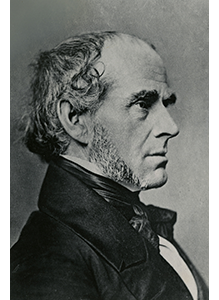
Emory Washburn Washburn was born in Leicester, MA, in 1800 to an old New England family. Among his ancestors was a member of the first Pilgrim company to set foot on Plymouth Rock and the first secretary of the Massachusetts Bay Company. His father died when he was seven and his mother saw to the details of his accelerated education. He enrolled at Dartmouth College at age 13 and transferred to Williams College two years later when one of his professors became president of that institution. At 17 he graduated and began the study of law. He was admitted to the bar in 1821 and returned to his hometown of Leicester to begin his law practice, serving for a time as the town clerk. He served Leicester in the state legislature until the death of his mother in 1828, when he moved to Worcester to take a post as an aide to the governor of Massachusetts. As a state representative, he suggested that the state build a rail line between Boston and Albany before Massachusetts had a single mile of railroad. In 1838 he won election to the U.S. House of Representatives, moving on in 1841 to the U.S. Senate, where he chaired the Judiciary Committee for two years. He served as a justice on the U.S. Court of Common Pleas for four years before making his way back to Massachusetts to run for governor. When the election results were counted in the fall of 1853, Washburn was in Europe. He did not learn of his victory until he deboarded a ship in Halifax, Nova Scotia. His term as governor lasted just one year, and shortly thereafter he was named Bussey Professor of Law at Harvard University. Between his appointment and his resignation in 1876, he wrote more than 50 books and pamphlets. He died two years later at the age of 78.
WPI Journal, Spring 1990 p.9
David Whitcomb
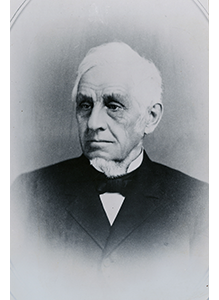
David Whitcomb’s life is a story of a remarkable triumph over adversity. Born in 1808 to Abner Whitcomb, who had been a minuteman in the Revolutionary War, he was bound out to a farmer at the age of seven. He spent his youth as a chore boy for one farmer or another, finally leaving his hometown of Hancock, NH, on foot when he was 18. He worked on a farm for a time and took a few odd jobs before his cousin, John Boynton, hired him as a tin peddler when he was 21. A year later Boynton made him a partner; in another year Boynton deemed Whitcomb ready to take charge of a branch operation in Leominster, MA. Boynton retired in 1846 and left the business in Whitcomb 's control. Two years later Whit- comb took on a new partner, to whom, in 1853, he sold his interest in the business. Having accumulated a tidy fortune, Whitcomb headed to Worcester to become a partner in a hardware company. He demonstrated his business acumen when, during the Civil War, he bought large quantities of hardware at panic prices. The transaction earned the business a substantial profit. In 1866, approaching 60 and with the business of getting WPI off the ground well under way, Whitcomb left the hardware firm and, with his son Henry, established the Whitcomb Envelope Company. The firm would grow into one of Worcester's most successful enterprises. Whitcomb served as a WPI trustee from 1865 until 1884 and was treasurer of the Institute from 1865 to 1876. His son was a trustee from 1884 until his death in 1916. David Whitcomb gave generously to the Institute during his life, his gifts amounting to more than $27,000. He died in 1887 at the age of 79.
WPI Journal, Spring 1990 p. 7
George Frisbie Hoar
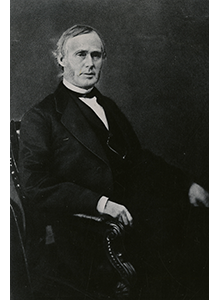
Hoar was already a rising star in Massachusetts politics when WPI was founded. Born in Concord, MA, in 1826 to a prominent Massachusetts family, Hoar counted among his ancestors an early Harvard president and a state senator. His father served in the state senate and the U.S. Congress. After graduating from Harvard and the Harvard Law School, Hoar came to Worcester to read law. He chose Worcester because of its reputation as a stronghold of the anti-slavery movement— his father was once driven from Charlestown, MA, while working to protect the rights of black seamen, a memory that stuck with Hoar. Hoar eventually established his own practice in Worcester and became quite successful. In 1849 he decided to follow in his father's footsteps and enter politics. He became chairman of the Free Soil Party in Worcester and, in 1851, won election as the youngest member of the Massachusetts General Court. He later ran successfully for a seat in the state Senate and, in 1868, was elected to the United States Congress. In 1877 his career took him to the U.S. Senate, where he served for 27 years. He was chairman of the 1880 Republican National Convention that nominated James Garfield for president. In Worcester, Hoar was instrumental in establishing the city's public library and was active in many Worcester organizations. So beloved was he of the city's citizens that when he died in 1904 a committee was immediately established to raise funds for his memorial. With $20,000 donated by 30,000 Worcester citizens, the committee commissioned Daniel Chester French to design a bronze statue of Hoar that stands near City Hall.
WPI Journal, Spring 1990 p.10